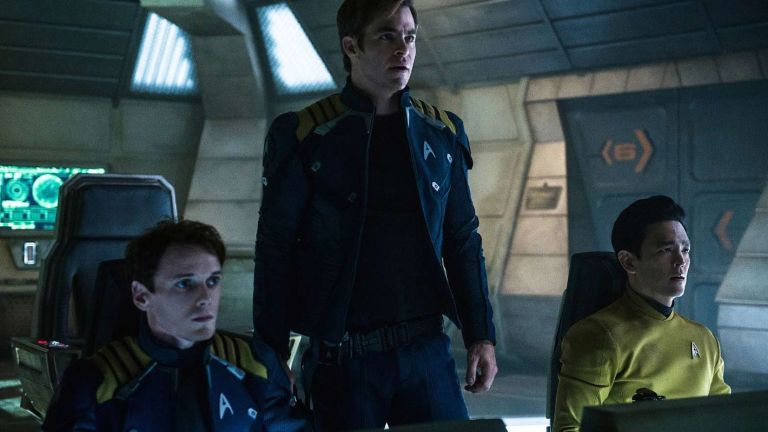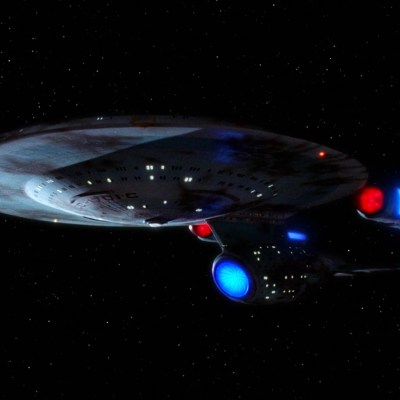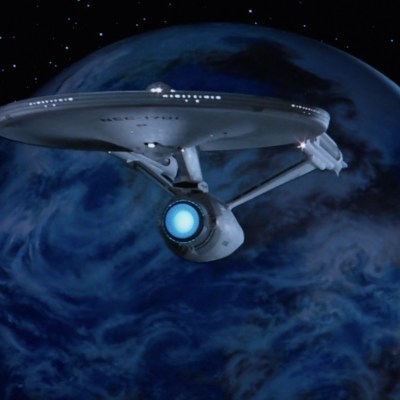How Star Trek Beyond Redefined the Prime Timeline
Star Trek Beyond is better than you remember, and thanks to some deep-cut Trek history, it also redefined the way we look at the entire franchise.

Four years ago, the Star Trek universe looked very, very different. At that time, there hadn’t been a new Star Trek series in five years, and the idea of three new seasons of different shows coming out in one year (as in 2020) would have seemed absurd. Way back in 2016, the year the franchise celebrated its 50th anniversary, there was only one new (filmed) Star Trek story released into the world: the movie Star Trek Beyond.
Contrast this with the 25th Anniversary of Star Trek in the year 1991: Spock crossed over to The Next Generation in the season 5 episode “Unification,” while the classic crew kicked-ass one last time in Star Trek VI: The Undiscovered Country. Hell, during the 30th anniversary of Trek in 1996, there were two shows on the air — Voyager and Deep Space Nine — and arguably, the greatest Trek movie ever in theaters: Star Trek: First Contact.
But, when the big five-o rolled around in 2016, it looked like Trek was coasting on impulse power. Fairly or not, Star Trek Beyond is nobody’s favorite Trek movie, and its reputation is only made trickier by the fact that, at the time, it had a lot of pressure on it to represent the whole of the franchise during such an important milestone.
And yet. Upon revisiting Beyond, there’s a lot for Trekkies to love about this flick. If it ends up becoming the last movie to feature the Kelvin Universe “reboot” crew, it’s a fitting send-off, made bittersweet by Anton Yelchin’s untimely death just before its release. Watching it now, with so much new Trek blooming everywhere, Beyond feels like a quaint love-letter sent hopefully into the future, one that tried to pack in as many references and tributes to all of Trek as quickly and artfully as possible. It doesn’t always work, and the trailers for the film did it a huge disservice, but this movie was for the fans even if the marketing made it seem like it wasn’t.
And, on top of all the wonderful Trek aesthetics, there’s one subtle way that Star Trek Beyond radically dove into the mythology of the Prime Universe timeline. When the movie reveals its biggest twist, late in the third act, we’re given a Starfleet history lesson that basically, explains why Starfleet is so weird and duplicitous throughout the entire franchise. In Star Trek II: The Wrath of Khan, David Marcus implies Starfleet is the military, and scientists are just their “pawns.” Star Trek Beyond tackles why this perception exists, and why it’s not entirely wrong.
The biggest revelation in Star Trek Beyond occurs towards the end of the film when we learn that, in the 22nd century, the reformation of Starfleet was partially the result of forced military integration. It turns out that a guy named Captain Balathaz Edison (Idris Elba) has mutated into the villainous alien known as Krall. When Scotty frantically looks up Edison’s service records, the crew is told Edison was a member of Military Assault Command Operations, better known as MACO in prequel series Star Trek: Enterprise.
In the context of Enterprise, MACO is an Earth-based military force that worked separately – and apart from – Starfleet (though starting in season 3 of Enterprise, several members of MACO were stationed somewhat permanently aboard the NX-01 Enterprise). This comes from a period of Trek history where Starfleet exists but the United Federation of Planets does not.
Analogously, MACO soldiers working on the NX-01 Enterprise would be like active duty Marines hitching a ride on a NASA operated spacecraft. Just because your spacecraft is carrying soldiers, it does not make those soldiers defacto members of NASA. However, the interesting wrinkle in Beyond is that, after the formation of the Federation in roughly 2160, several members of MACO were apparently made into Starfleet officers. As Scotty puts it in the film: “His military service came to an end when MACO was disbanded… the Federation, Starfleet… we’re not a military agency.”
The backstory for Balthazar Edison recontextualizes almost everything we know about Starfleet history. In the series Enterprise, the formation of the Federation and the evolution of Starfleet was only briefly glimpsed. Not counting the flash-forward in the series finale (which is a holographic simulation, technically) Enterprise showed Starfleet from the years 2151 to 2155. The Federation and the “new” Starfleet doesn’t really exist until after 2160 or 2161, and Captain Edison is literally the only Trek character we’ve met who lived through this time period.
Relative to Prime Canon, all of this counts because everything that happened in Enterprise is still the backstory for the Kelvin Universe movies — the timeline divergence doesn’t occur until nearly 70 years after the end of Enterprise, in the year 2233. This, by the way, is why Scotty makes jokes about “Admiral Archer’s prized beagle” in Trek 2009; Jonathan Archer was probably pushing 140 or so and was, in effect, the exact same character with the same experiences that he’d had in Enterprise.
Balthazar Edison is from that era, but unlike Archer, he didn’t want to be part of Starfleet; instead, he became Starfleet out of necessity. Throughout the rest of Trek canon, we see this distinction crop up in interesting places. There are Starfleet “officers,” but there are also “enlisted” crewmembers like Chief O’Brien, or Crewman Simon Tarsus in the TNG episode “The Drumhead.”
Starfleet has two identities: it’s an idealistic exploration agency, but also a future version of the military, where people do jobs that are not 100 percent related to all of that idealistic stuff. And, the story of Edison helps to reveal the origins of how all that works. Scotty mentions “they made him a Captain and g[a]ve him a ship.”
Later in the film, Edison mentions fighting the Xindi and the Romulans. This references the unseen Romulan War of the 22nd century, but also the Xindi conflicts from Enterprise Season 3. In fact, mentioning the Xindi at all must mean that Balthazar, at some point, was a MACO soldier stationed on the Enterprise NX-01 and worked with, or alongside Archer’s crew.
This is actually pretty cool if you think about it. Nearly everything about Enterprise Season 3 is about Archer being forced to change the mission of the ship from exploration to warfare. In the fight against the Xindi, you can see the two sides of Starfleet start to coalesce: Yes, it’s a peaceful science organization, but because they run all the spaceships, they also have to fight unfriendly aliens sometimes.
Everything Balthazar experiences in Star Trek Beyond is an extension of this same dichotomy but from the other side. Archer was a guy forced to become more like Balthazar in season 3 of Enterprise. Balthazar, it seems, was someone who, after the Romulan War ended, had to become more like Archer. And, given the fact that we can almost certainly conclude he was actually on the first NX-01 Enterprise, it makes Idris Elba’s one and only Trek character a little more pivotal than you probably thought.
Throughout the whole canon of Star Trek, the exploration of Starfleet often wavers between its militaristic underpinnings and its aspirational ethics. Through Balthazar Edison and the story of the USS Franklin, what Beyond made clear is where that dichotomy originates. In some ways, it’s what the movie is actually about. Starfleet wasn’t just founded by a group of explorers and scientists. Turns out, some of the earliest Starfleet captains and crew were just out-of-work starship troopers looking for a steady gig.


